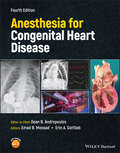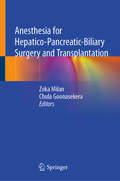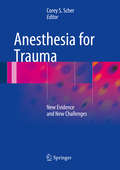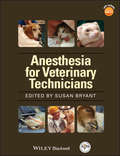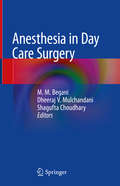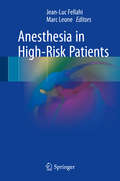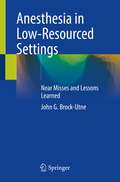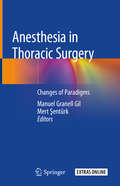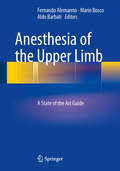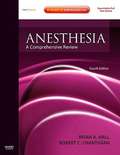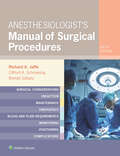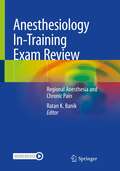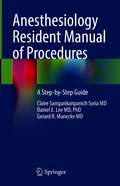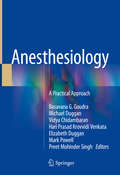- Table View
- List View
Anesthesia for Congenital Heart Disease
by Dean B. AndropoulosAnesthesia forCongenital Heart Disease An Extensive Reference Work Detailing the Procedures, Knowledge, and Approaches in Anesthesia for Congenital Heart Disease In this fourth edition of Anesthesia for Congenital Heart Disease, a distinguished group of expert authors in congenital heart disease (CHD) from all over the world provide a thorough, comprehensive, and fully updated overview of the specifics of congenital heart disease and the intricacies involved with administering anesthetic care to patients who suffer from the myriad of lesions encompassed by CHD. In the seven years since the third edition of Anesthesia for Congenital Heart Disease was published, an explosion of new procedures, approaches, and patients eligible for anesthetic care has occurred. The goal of Anesthesia for Congenital Heart Disease, Fourth Edition is to help readers understand all of the recent advancements and developments in the field while also imparting a foundation of essential historical knowledge. The book contains new chapters that reflect exciting new approaches in this rapidly changing field, and also includes: Updated information in the chapter Adult Congenital Heart Disease and Mechanical Support of the Circulation, reflecting the increasing prominence of these patients in CHD care New chapters on Informatics and Artificial Intelligence, Genetic Syndromes, Point of Care Ultrasound, and Cardiopulmonary Resuscitation in Congenital Heart Disease Thorough updates of all chapters with many new figures and tables, and hundreds of new recent references provide up to date information Anesthesia for Congenital Heart Disease, Fourth Edition serves as a thorough and in-depth reference work and is an essential resource for practitioners providing perioperative care to CHD patients.
Anesthesia for Dental and Oral Maxillofacial Surgery
by Spencer D. Wade Caroline M. Sawicki Megann K. Smiley Michael A. Cuddy Steven Vukas Paul J. SchwartzAnesthesia for Dental and Oral Maxillofacial Surgery A comprehensive reference to anesthesia for dental, oral, and maxillofacial surgery Anesthesia for Dental and Oral Maxillofacial Surgery offers a comprehensive yet practical approach to anesthesiology for dentist anesthesiologists, oral and maxillofacial surgeons, and anesthesia providers in a dental environment. Taking a concise bulleted approach for fast access to information, the book covers all topics relevant to providing perioperative anesthetic management for the head and neck region. Coverage ranges from equipment, anatomy, physiology, and pharmacology to anesthetizing patients with specific conditions and for specific procedures. Designed for ease of use, the book makes it easy to find information relevant to cases ranging from common to rare. Anesthesia for Dental and Oral Maxillofacial Surgery readers will also find: Images throughout to facilitate key points A bulleted approach for easy reference A practical, accessible style, making it easy to find information at point of care Detailed coverage of preoperative aspects, pharmacology, key equipment, and more Anesthesia for Dental and Oral Maxillofacial Surgery provides anesthesia providers with all the information they need to confidently manage any case.
Anesthesia for Hepatico-Pancreatic-Biliary Surgery and Transplantation
by Zoka Milan Chula GoonasekeraThis concise, accessible book covers anesthesia for hepatico-pancreatic-biliary (HPB) surgery and transplantation, based on randomized clinical trials, meta-analyses, case series, reports, and hands-on experience. The anatomy, physiology, pathophysiology and clinical consequences are discussed, and the close ties between HPB resection and transplant anesthesia are explored. The content reflects current real-world practice, as liver and pancreatic transplant surgeries have substantially improved in terms of blood-loss reduction, fast tracking and reduced risk. The book also addresses anesthetic aspects in connection with the recently introduced and rapidly expanding practice of laparoscopic surgery; with enhanced recovery; and with pancreatic surgery. Anesthesia for Hepatico-Pancreatic-Biliary Surgery and Transplantation is intended for aspiring HPB and transplant anesthetists, anesthesia trainees, and consultants with experience in HPB anesthesia who want to see whether or not they’re up to date on the current standards.
Anesthesia for Maternal-Fetal Surgery: Concepts and Clinical Practice
by Olutoyin A. OlutoyeWith advances in ultrasound, birth defects are increasingly detected during pregnancy and may be amenable to surgical correction before delivery, to improve outcomes. This essential book discusses the different birth defects that can be treated during pregnancy and the important anesthetic considerations for the mother and fetus undergoing these procedures. Experts in the fields of anesthesiology, maternal fetal medicine, surgery, and pediatrics have come together to develop the content of this book. Enhanced throughout with full color images and illustrations, the book covers important topics such as spina bifida, twin-twin transfusion syndrome, sacrococcygeal teratoma, and lung masses, as well as fetal cardiac intervention, intrauterine transfusion, ex utero intrapartum treatment, and multidisciplinary approaches to fetal surgery. An invaluable guide for pediatric and obstetric anesthesiologists, anesthesiology, obstetrics, and surgical trainees, nurse anesthetists, and maternal-fetal medicine specialists.
Anesthesia for Oncological Surgery
by Henry Liu Jeffrey Huang Jiapeng HuangThis book fills the need for a single comprehensive work on oncological anesthesia written by anesthesiologists. Divided into 14 distinct sections, this title includes the most up-to-date surgical oncologic procedures/treatments (new adjunctive treatments, new surgical techniques), perioperative care and anesthetic considerations and protocols. The highly experienced authors explain how the new treatments affect anesthesia implementations. Chapters are formatted to be “Comprehensive and Concise”, COMPREHENSIVE means the book will cover almost everything related to the anesthetic management of oncological surgical procedures and treatment, CONCISE means each chapter will be practical in format to include surgical highlights, positions, paralysis, anesthesia options, monitoring, durations, anesthesia key points, postoperative analgesia, and postoperative destinations”. An invaluable resource for anesthesiologists, certified registered nurse anesthetists (CRNA), certified Anesthesiologist assistants (CAA), anesthesia trainees (anesthesiology residents/fellows, students registered nurse anesthetists, student Anesthesiologist assistants), and oncological surgeons.
Anesthesia for Oral and Maxillofacial Surgery
by Hong Jiang Ming XiaThis book reviews and describes anesthetic management of patients during oral and maxillofacial surgery. It covers applied anatomy of oral and maxillofacial surgery, difficult airway management and anesthetic techniques. The anesthetic management for patients with oral and maxillofacial disorders such as head and neck infection, head and neck injuries, and head and neck malignancy is also discussed. It will be a concise, up-to-date reference for specialists in anesthesiology, as well as practitioners in oral and maxillofacial surgery. It aims to share up-to-date knowledge and practical techniques with those who work in the fields related to oral and maxillofacial surgery.
Anesthesia for Otolaryngologic Surgery
by John Doyle Basem AbdelmalakAnesthesia for Otolaryngologic Surgery offers a comprehensive synopsis of the anesthetic management options for otolaryngologic and bronchoscopic procedures. Authored by world authorities in the fields of anesthesiology and otolaryngology, both theoretical concepts and practical issues are addressed in detail, providing literature-based evidence wherever available and offering expert clinical opinion where rigorous scientific evidence is lacking. A full chapter is dedicated to every common surgical ENT procedure, as well as less common procedures such as face transplantation. Clinical chapters are enriched with case descriptions, making the text applicable to everyday practice. Chapters are also enhanced by numerous illustrations and recommended anesthetic management plans, as well as hints and tips that draw on the authors' extensive experience. Comprehensively reviewing the whole field, Anesthesia for Otolaryngologic Surgery is an invaluable resource for every clinician involved in the care of ENT surgical patients, including anesthesiologists, otolaryngologists and pulmonologists.
Anesthesia for Spine Surgery
by Ehab FaragThe increased complexity of spinal surgical procedures in recent years has required more sophisticated anesthetic management of patients undergoing these procedures. Spine surgery anesthesia is now recognized as a distinct sub-specialty, increasingly undertaken by general anesthesiologists as well as neuroanesthesiologists. Anesthesia for Spine Surgery describes the anesthetic management and surgical procedures at every vertebral level in both adult and pediatric patients. The most important related considerations are covered, including: * Postoperative pain management * One lung ventilation during anterior thoracic spine surgery * Intraoperative neuromonitoring * Fluid management Additional chapters review the radiological features of normal and abnormal spines, common complications of spine surgery and ASA closed claims relating to spine surgery anesthesia. Written by highly experienced neuroanesthesiologists and spine surgeons, Anesthesia for Spine Surgery is essential reading for trainee and practising anesthesiologists, neuroanesthesiologists and spine surgeons.
Anesthesia for Trauma: New Evidence and New Challenges
by Corey S. ScherTrauma is the leading cause of death among people under the age of 40 and it ranks third for all age groups. Still, relatively few clinicians specialize in trauma and training is often obtained through experience The number of trauma patients is expected to continue to grow as pre-hospital care continues to advance. As well, hospitals increasingly see trauma treatment, which requires no pre-approval, as a good source of revenue. Given these developments, the number of opportunities for specialists trained in trauma, including anesthesiologists and critical care physicians, will expand in the years ahead. This book addresses the need for an up-to-date, comprehensive and clinically focused volume for practitioners and trainees in trauma anesthesia and critical care. It is organized by organ system. The editor is an attending physician at a major urban hospital center recognized worldwide for its outstanding emergency medical services including trauma care and is recruiting leading trauma anesthesiologists to contribute. Anesthesiologists, pain medicine physicians, critical care physicians and trainees are the target audience.
Anesthesia for Urologic Surgery
by Ethan O. Bryson Elizabeth A. Frost Daniel M. GainsburgThis is a concise, up-to-date reference on anesthesia for urological surgery. Urological anesthesia is not recognized as a specialty, and a majority of anesthesiologists and nurse anesthetists will provide anesthesia for these patients. Advances in urological procedures, the advent of treatment of patients with strong anticoagulant and antiplatelet medications, and the demographics of urology patients (many of whom are young or elderly) present challenges for the anesthesiologist and have necessitated changes in anesthesia practice. The last volume on this topic was published in 2000, and the time is right for a fresh presentation of contemporary expertise in anesthesia for urological surgery. The book provides a brief review of renal physiology and pharmacology then addresses anesthesia for each major group of urological procedures (e.g., endoscopic, office-based, laparoscopic and robotic, nephrolithotripsy, renal transplantation, etc.) and in special populations, including the geriatric patient, the pediatric patient, and the pregnant patient. Separate chapters discuss the unique challenges of positioning the patient, and of managing the patient taking anticoagulant and antiplatelet medication, and the chapter on pain management addresses common and important perioperative concerns. The book provides a brief review of renal physiology and pharmacology then addresses anesthesia for each major group of urological procedures (e.g., endoscopic, office-based, laparoscopic and robotic, nephrolithotripsy, renal transplantation, etc.) and in special populations, including the geriatric patient, the pediatric patient, and the pregnant patient. Separate chapters discuss the unique challenges of positioning the patient, and of managing the patient taking anticoagulant and antiplatelet medication, and the chapter on pain management addresses common and important perioperative concerns.
Anesthesia for Veterinary Technicians
by Susan BryantAnesthesia for Veterinary Technicians is a highly practical guide to anesthesia skills for veterinary technicians published in association with the Academy of Veterinary Technician Anesthetists (AVTA). Packed with hints and tips to aid technicians in the practice of veterinary anesthesia, the book offers an essential resource to building anesthesia skills and improving knowledge. Encompassing both background knowledge and practical application of anesthesia-related skills, Anesthesia for Veterinary Technicians is a valuable resource for veterinary technicians of all skill levels.Supplementary website materials, including charts and forms for use in the practice, are available at www.wiley.com/go/bryant.
Anesthesia in Day Care Surgery
by M. M. Begani Dheeraj V. Mulchandani Shagufta ChoudharyThis book features a collection of guidelines for anesthesia in day care surgery, covering all medical specialties that may look to venture into the ambulatory surgery domain. It provides various practical tips that can be used in day-to-day practice by anesthetists and surgeons alike, and covers various anesthetic protocols used by the stalwarts of the industry to illustrate the ideal techniques for anesthesia in day care surgery.
Anesthesia in High-Risk Patients
by Marc Leone Jean-Luc FellahiThis book describes the approach to anesthetic and perioperative management in different categories of high-risk patient scheduled to undergo elective noncardiac surgery. Individual sections focus on patients with conditions entailing cardiac and hemodynamic risks, respiratory risks, renal and metabolic risks, neurological risks, and other forms of risk. For each condition, up-to-date guidance is provided on risk evaluation, risk stratification, and intraoperative and postoperative anesthetic management. This is the first time that such different clinical situations have been gathered together in a single textbook of anesthesiology. All of the authors are international experts with extensive clinical experience. The aim is to provide trainee anesthesiologists with clear guidance that will prove invaluable when managing a wide range of patients with serious illnesses or conditions that pose a significant anesthetic risk. The book will also serve as a valuable reference for more experienced anesthesiologists and intensivists.
Anesthesia in Low-Resourced Settings: Near Misses and Lessons Learned
by John G. Brock-UtneThis book outlines the many anesthesia-related obstacles, concerns, and challenges that may be encountered by western trained anesthesiologist in low-resourced settings. Each chapter presents a challenging scenario with solutions. It is therefore an essential handbook that will prepare those performing anesthesia in this milieu. All case studies represent real accounts discussing equipment and drug constraints as well as the ethical questions that arise for western doctors working in this environment.Socially conscious and timely, Anesthesia in Low-Resourced Settings is an invaluable resource for medical practitioners who plan to work in these challenging settings.
Anesthesia in Thoracic Surgery: Changes of Paradigms
by Mert Şentürk Manuel Granell GilThis book reviews and describes the best practices of anesthesia in thoracic surgery, according to evidence-based medicine. It covers preoperative assessment, applied pharmacology, airway management and ventilation methods. The analgesic methods in this surgical specialty are also discussed. This book is aimed at all specialists in the world of anesthesiology and critical care as well as to physicians in training. It may also be of interest to thoracic surgeons and pulmonologists.
Anesthesia of the Upper Limb: A State of the Art Guide
by Fernando Alemanno Mario Bosco Aldo BarbatiLoco-regional anesthesia offers evident advantages in almost all branches of surgery since it couples perfect anesthesia with prolonged postoperative analgesia. Furthermore, new drugs and techniques are ensuring constant progress, and in the past decade the advent of ultrasound-guided regional anesthesia has played a key role by allowing direct visualization of all anatomic structures involved in regional blocks. In conjunction with electrostimulation, it has significantly increased the success rate of loco-regional anesthesia. This book, comprising 16 chapters and more than 140 color illustrations, provides detailed coverage of the techniques currently employed in upper limb anesthesia. It opens by reviewing the anatomy of the brachial plexus and the topographic anatomy as it is of the utmost importance for anesthesiologists to have a deep knowledge of anatomy despite the assistance offered by new tools. Subsequently the various techniques, including supraclavicular, infraclavicular, and axillary brachial plexus blocks, peripheral blocks, and intravenous regional anesthesia, are discussed in depth, with due attention to potential complications. Up-to-date information is also provided on the role of ultrasound, and an entire chapter is devoted to ultrasound-guided interscalene and supraclavicular blocks. The book will be an invaluable learning tool for students and an excellent aid in daily clinical practice for anesthesiologists.
Anesthesia: A Comprehensive Review (Fourth Edition)
by Brian A. Hall Robert C. ChantigianAnesthesia: A Comprehensive Review is an invaluable study tool for certification and recertification as well as a superb way to ensure mastery of all the key knowledge in anesthesiology. Brian A. Hall and Robert C. Chantigian present nearly 1000 completely updated review questions-vetted by Mayo residents-that cover the latest discoveries and techniques in physics, biochemistry, and anesthesia equipment; the newest drugs and drug categories; and the most recent information on all anesthesia subspecialties. They cover everything from the basic sciences to general anesthesia and subspecialty considerations, with an emphasis on the most important and clinically relevant principles. Access discussions of each question as well as page references to major anesthesia texts. With online access to the text at expertconsult. com, you'll have the ultimate review guide for the ABA written exam. Tests your knowledge of anesthesia through the most comprehensive coverage of basic science and clinical practice for an effective review. Features questions vetted by Mayo residents to ensure a consistent level of difficulty from trustworthy sources. Features the full text online at expertconsult. com for convenient reference. Presents 997 thoroughly revised questions for the most current and comprehensive review of board material, covering the latest discoveries and techniques in physics, biochemistry, and anesthesia equipment; the newest drugs and drug categories; and the most recent information on all anesthesia subspecialties. Complies with the new ABA format so you have an accurate representation of the new question style and can prepare effectively. Includes discussions after each question, along with references to major anesthesia texts so it's easy to find more information on any subject.
Anesthesia: The Gift of Oblivion and the Mystery of Consciousness
by Kate Cole-Adams"An obsessive, mystical, terrifying, and even phantasmagorical exploration of anesthesia’s shadowy terra incognita." —The New YorkerAnesthetize: to render insensibleFirst there’s the injection, then the countdown—and next thing you know, you’re awake. Anesthesia: The Gift of Oblivion and the Mystery of Consciousness is the story of the time in between, an exploration of that most crucial and baffling gift of modern medicine: the disappearing act that enables us to undergo procedures that would otherwise be impossibly, often fatally, painful. In the past 150 years, anesthesia has made surgical intervention routine, from open–heart surgery to the facelift. But how much do anesthesiologists really know about what happens when their patients go under? Can we hear and retain what’s going on? Is pain still pain if we don’t remember it? How does the unconscious mind deal with the body’s experience of being sliced open and ransacked—and how can we help ourselves through it all?Kate Cole–Adams weaves her own personal experiences with surgery and its aftermath with the explorations and personal accounts of others, doctors and patients alike—accounts of people who wake under the knife, who experience traumatic reactions, dreams, hallucinations, and submerged memories—accounts that evoke and illuminate the provisional nature of the self.Haunting, lyrical, sometimes shattering, Cole–Adams leavens science with personal experience, and brings an intensely human curiosity to the unknowable realm beyond consciousness.
Anesthesiologie (Quintessens)
by P. J. Hennis J. A. LeusinkAnesthesiologen hebben een breed takenpakket, zich uitstrekkend van het zelf uitvoeren van algehele en regionale anesthesie op behandel- en operatiekamers tot de coördinatie van behandeling en logistiek op de afdelingen spoedeisende hulp en intensive care. Nu eens zetten zij hun vakkennis in voor een pasgeborene van een halve kilogram, dan weer voor een hoogbejaarde patiënt met een marginale hartfunctie. De anesthesiologie heeft raakvlakken met zowel de beschouwende als de snijdende disciplines en vervult daardoor een spilfunctie in het ziekenhuis. Leerboek anesthesiologie biedt een gedegen basis voor dit veelzijdige vak. Deze herziene en geactualiseerde druk bestaat uit zes delen: het operatiekamercomplex, monitoring en apparatuur; farmaca; basisprincipes van anesthesie en intraoperatieve problematiek, preoperatieve screening; speciële anesthesie; postoperatieve zorg, pijnbestrijding en reanimatie. Elk hoofdstuk begint met een korte inleiding, bevat een discussie over een controversieel onderwerp in de anesthesiologie en eindigt met een samenvatting in kernpunten. In de operatiekamer is het contact met de patiënt vaak van korte duur, terwijl de anesthesioloog op de intensive care en bij de chronische pijnbestrijding een langduriger contact met de patiënt heeft. Veel anesthesiologen hebben zich gespecialiseerd in de intensivecaregeneeskunde, in bestrijding van chronische pijn of in de palliatieve zorg. De anesthesioloog speelt ook een beslissende rol in reanimatiesituaties. Ook op deze onderwerpen wordt ingegaan. Leerboek anesthesiologie is bestemd voor studenten geneeskunde, anesthesieverpleegkundigen en -technici en assistenten anesthesiologie en chirurgie. Het boek is geschreven door anesthesiologen die werkzaam zijn in opleidingscentra voor anesthesiologie en perifere ziekenhuizen in Nederland.
Anesthesiologist's Manual of Surgical Procedures
by Richard A. Jaffe Clifford Schmiesing Brenda GolianuCovering both surgical and anesthetic considerations, Anesthesiologist’s Manual of Surgical Procedures, Sixth Edition, is an essential resource for formulation of an anesthetic plan and perioperative management of patients. All chapters are written by both surgeons and anesthesiologists, giving you a detailed, real-world perspective on the many variables that accompany today’s surgical procedures.
Anesthesiology In-Training Exam Review: Regional Anesthesia and Chronic Pain
by Ratan K. BanikFocused on rotations in regional anesthesia and chronic pain, this book provides a structured review of the concepts covered in the American Board of Anesthesiology in-training exam. The first section of the book covers regional anesthesia with dedicated chapters on basic science, acute postoperative pain, and nerve blocks for neuraxial, lower and upper extremity blocks, and head and neck. The second section on chronic pain includes chapters on basic science and common pain conditions - including craniofacial pain, CRPS, neuropathic pain, and cancer pain. This section closes on multimodal analgesia and other treatment approaches. Each chapter presents a common clinical topic and is organized by indications, preparation, technique, complication, prevention, clinical pearls, and related ABA key points. Highlights must-know information in bold throughout the text. Concise, practical, and easy-to-read, this book will aid anesthesiology residents, certified nurse anesthetists, and medical students in their study regarding patient care practices on regional anesthesia and chronic pain. The book will also be useful to residents going into regional anesthesia and pain medicine subspecialties during the year of their anesthesiology training.
Anesthesiology Resident Manual of Procedures: A Step-by-Step Guide
by Claire Sampankanpanich Soria MD Daniel E. Lee MD, PhD Gerard R. Manecke MDThis book describes in concise yet detailed step-by-step instructions on how to perform common procedures, including complex airway management, vascular access, neuraxial blocks, and nuanced anesthetic techniques; it not only covers this breadth of procedures, but presents them in an accessible manner. Chapters follow the format of the indications for a particular procedure, a list of equipment required, step-by-step instructions for performing the procedure, common complications, and troubleshooting techniques. The book is designed intentionally for the busy physician to be able to easily read the essential information, including lists of equipment necessary, numbered steps to perform the procedure, tables of common errors and methods to troubleshoot, indications and contraindications for procedures, detailed photos of equipment setup, and handmade diagrams and images. Anesthesiology Resident Manual of Procedures is comprehensive and written with the physician-in-training in mind, as well as those who are completing their residency or fellowship in the fields of anesthesiology, critical care medicine, and emergency medicine.
Anesthesiology Simulation: A Complete Education Guide for Instructors and Trainees
by Claire Sampankanpanich Soria Phil YaoThis book is a curriculum that is essentially an easy-to-follow educational instruction manual. It is a ready-made simulation program that any instructor, whether they are a physician in training or in practice, can read and execute. It is designed so that an instructor can select a topic, open that chapter, and with appropriate simulation equipment and staff, run an entire simulation scenario from start to finish. Each chapter is a unique medical case that concludes with an associated scoring rubric for learners. It sets clear expectations for clinical knowledge as well as leadership and communication skills. Students can also use the scoring rubrics as self-evaluations to identify areas for improvement. Anesthesiology Simulation presents classic index cases that every anesthesiologist, general surgeon, and obstetrician/gynecologist should know how to handle. These are simulation cases that were written to be done together, with surgeons or obstetricians collaborating with anesthesiologists.
Anesthesiology and Otolaryngology
by Adam I. Levine Samuel Demaria Jr. Satish GovindarajTo an unusual degree, the shared "working space" of otolaryngologists and anesthesiologists means that issues important to one are important to the other. Anesthesiology and Otolaryngology is the first book to address the closely overlapping information needs of both groups of specialists. It is collaboratively written and edited by anesthesiologists and otolaryngologists, and the chapters are carefully designed to insure maximal relevance to members of both specialties. The heart of the book consists of chapters on managing patients during the full range of otolaryngologic procedures. These chapters are structured chronologically, and otolaryngologic and anesthesiologic perspectives are systematically presented for each operative stage. Foundational topics such as gross and radiographic anatomy, physiology, and pharmacology are covered. The book includes a unique chapter on oxygen delivery systems that serves as a comprehensive review for anesthesiologists and an overview for the otolaryngologist. Special topics addressed include acute and chronic pain management, and the logistics of managing an office-based surgical practice. · "All-in-one" reference for otolaryngologists and otolaryngologic anesthesiologists · Surgical and anesthesiologic perspectives marshaled for pre-operative, intraoperative, and postoperative periods · Pearls and Insights at end of chapters · Organized by surgical region · Special challenges of difficult airway and of pediatric otolaryngologic procedures addressed
Anesthesiology: A Practical Approach
by Mark Powell Basavana G. Goudra Preet Mohinder Singh Michael Duggan Vidya Chidambaran Hari Prasad Venkata Elizabeth DugganThis book provides a practical approach to the anesthetic management of surgical and nonsurgical procedures across the spectrum of anesthesia sub-specialties. This book will assist the practitioner to plan their anesthetic from preoperative evaluation phase to complete recovery or transfer to another special care area. The emphasis is on both the planned technique and more importantly the logic or reasoning behind the suggested technique.This book addresses all important procedures in anesthesiology, including preoperative evaluation, airway management, and fluid administration. Every chapter discusses a specific surgery or procedure. Some topics of special interest are also included.Anesthesiology: A Practical Approach is aimed at anesthesia residents, anesthesia nurse practitioners, and experienced anesthesiologists called upon to work in any area or anesthetizing location.
